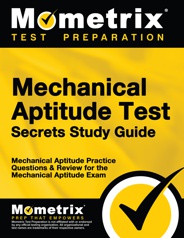If you need help studying for a mechanical aptitude test or just want some more information about what these tests are like, you’ve come to the right place.
Click below to take a free mechanical aptitude practice test!
What’s a Mechanical Aptitude Test?
Mechanical aptitude tests measure how well you understand mechanical ideas and can use them to solve real-world problems. Usually, you take a mechanical aptitude test when applying for a job that requires mechanical knowledge and skill.
What’s on the Test?
Every test is different, but these are the most common topics you’ll come across:
Basic Physical Forces
- Gravity
- Friction
- Velocity/acceleration
- Heat
- Pressure
Simple Machines
- Levers
- Pulleys
- Gears
- Springs
- Inclined planes
Fluid Mechanics
- Pressure transmission
- Hydraulic systems
Basic Electricity
- Circuits
- Voltage, current, and resistance
- Switches
Other/Misc.
- Tools and shop knowledge
- Spatial reasoning
- Shop arithmetic
Mechanical Aptitude Test Examples
As mentioned earlier, there are many different tests out there. Here are some examples to give you an idea what of some are like:
This is the most popular mechanical aptitude test in the US, used in fields like engineering, airlines, skilled trades, and emergency services. The main components you’re tested on are:
- Mechanical comprehension
- Spatial visualization
- Knowledge of basic physical and mechanical laws
- Technical deduction of how machinery works
The test contains 55 questions and is timed at 25 minutes.
Wiesen Test of Mechanical Aptitude (WTMA)
This test is often used in industries like construction, manufacturing, and engineering, as well as in academic research.
The main topics on this test are:
- Concepts of basic machinery
- Movement of objects
- Gravity/center of gravity
- Heat conduction
- Basic electricity/electronics
- Basic physical properties of matter and materials
The test contains 60 questions and is timed at 30 minutes.
Armed Services Vocational Aptitude Battery (ASVAB)
The ASVAB is used by the US military to determine how successful recruits will be overall and which military jobs they’ll be best suited for.
The mechanical comprehension questions on the ASVAB cover these topics:
- Levers, pulleys, and gears
- Inclined planes and wedges
- Wheel and axle systems
- Hydraulics and pneumatics
- Simple electrical circuits
- Properties of materials
- Newton’s laws of motion
- Work, power, and energy
- Fluid dynamics
This part of the ASVAB test contains 15-25 questions and is timed at about 20 minutes.
Mechanical Aptitude Study Guide
Get practice questions, detailed study lessons, and complex subjects broken down into easily understandable concepts.
 Get Your Study Guide
Get Your Study Guide
FAQs
What is on a mechanical aptitude test?
These tests are designed to assess how well you know about machines and physics, as well as how certain machines and tools are used.
What is the most popular mechanical aptitude test?
The BMCT and WTMA are both very popular mechanical reasoning tests.
What is a passing score on a mechanical aptitude test?
Every test is different. If you’re taking the test as part of a job application, it’s likely that your employer will have a specific score in mind.
How long is a mechanical aptitude test?
Every test is different, but they usually take somewhere around 20-30 minutes.

